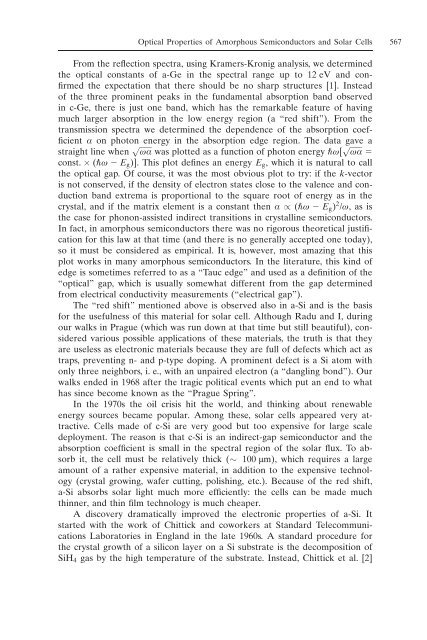10. Appendix
You also want an ePaper? Increase the reach of your titles
YUMPU automatically turns print PDFs into web optimized ePapers that Google loves.
Optical Properties of Amorphous Semiconductors and Solar Cells 567<br />
From the reflection spectra, using Kramers-Kronig analysis, we determined<br />
the optical constants of a-Ge in the spectral range up to 12 eV and confirmed<br />
the expectation that there should be no sharp structures [1]. Instead<br />
of the three prominent peaks in the fundamental absorption band observed<br />
in c-Ge, there is just one band, which has the remarkable feature of having<br />
much larger absorption in the low energy region (a “red shift”). From the<br />
transmission spectra we determined the dependence of the absorption coefficient<br />
· on photon energy in the absorption edge region. The data gave a<br />
straight line when √ ˆ· was plotted as a function of photon energy ˆ[ √ ˆ· <br />
const. × (ˆ Eg)]. This plot defines an energy Eg, which it is natural to call<br />
the optical gap. Of course, it was the most obvious plot to try: if the k-vector<br />
is not conserved, if the density of electron states close to the valence and conduction<br />
band extrema is proportional to the square root of energy as in the<br />
crystal, and if the matrix element is a constant then · ∝ (ˆ Eg) 2 /ˆ, asis<br />
the case for phonon-assisted indirect transitions in crystalline semiconductors.<br />
In fact, in amorphous semiconductors there was no rigorous theoretical justification<br />
for this law at that time (and there is no generally accepted one today),<br />
so it must be considered as empirical. It is, however, most amazing that this<br />
plot works in many amorphous semiconductors. In the literature, this kind of<br />
edge is sometimes referred to as a “Tauc edge” and used as a definition of the<br />
“optical” gap, which is usually somewhat different from the gap determined<br />
from electrical conductivity measurements (“electrical gap”).<br />
The “red shift” mentioned above is observed also in a-Si and is the basis<br />
for the usefulness of this material for solar cell. Although Radu and I, during<br />
our walks in Prague (which was run down at that time but still beautiful), considered<br />
various possible applications of these materials, the truth is that they<br />
are useless as electronic materials because they are full of defects which act as<br />
traps, preventing n- and p-type doping. A prominent defect is a Si atom with<br />
only three neighbors, i. e., with an unpaired electron (a “dangling bond”). Our<br />
walks ended in 1968 after the tragic political events which put an end to what<br />
has since become known as the “Prague Spring”.<br />
In the 1970s the oil crisis hit the world, and thinking about renewable<br />
energy sources became popular. Among these, solar cells appeared very attractive.<br />
Cells made of c-Si are very good but too expensive for large scale<br />
deployment. The reason is that c-Si is an indirect-gap semiconductor and the<br />
absorption coefficient is small in the spectral region of the solar flux. To absorb<br />
it, the cell must be relatively thick (∼ 100 Ìm), which requires a large<br />
amount of a rather expensive material, in addition to the expensive technology<br />
(crystal growing, wafer cutting, polishing, etc.). Because of the red shift,<br />
a-Si absorbs solar light much more efficiently: the cells can be made much<br />
thinner, and thin film technology is much cheaper.<br />
A discovery dramatically improved the electronic properties of a-Si. It<br />
started with the work of Chittick and coworkers at Standard Telecommunications<br />
Laboratories in England in the late 1960s. A standard procedure for<br />
the crystal growth of a silicon layer on a Si substrate is the decomposition of<br />
SiH4 gas by the high temperature of the substrate. Instead, Chittick et al. [2]










